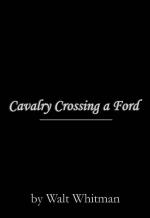|
This section contains 411 words (approx. 2 pages at 400 words per page) |

|
"Cavalry Crossing a Ford" is written in free verse, which means it adheres to no set pattern of rhyme or meter. Instead, it is organized around units composed of images and incorporates consonance and assonance in order to heighten the musicality of its verses.
Imagery refers to language used to communicate a visual picture or impression of a person, place, or thing. Images are usually defined as either fixed or free. "Fixed images," also sometimes called "concrete images," are specific and detailed enough so as to leave little to the reader's imagination. In contrast, free images are more general and depend upon the reader to provide specificity. In "Cavalry Crossing a Ford," for example, Whitman provides a series of images (both fixed and free) to present for the reader the larger picture of the cavalry troop. He writes of the "silvery river" and "the splashing horses loitering . . . to...
|
This section contains 411 words (approx. 2 pages at 400 words per page) |

|




